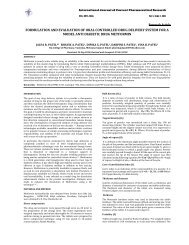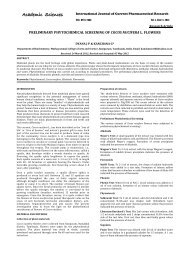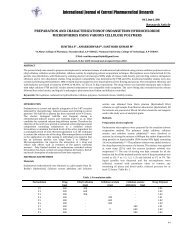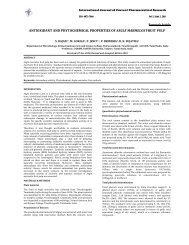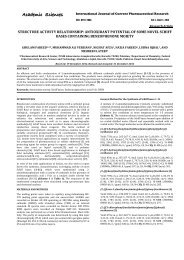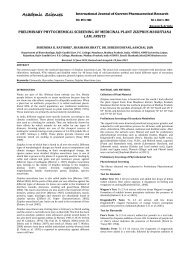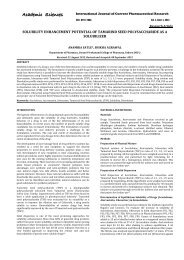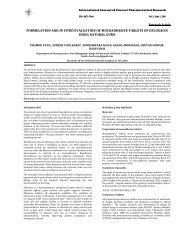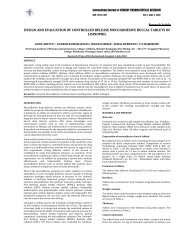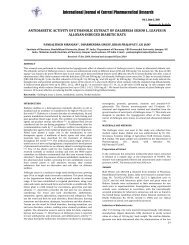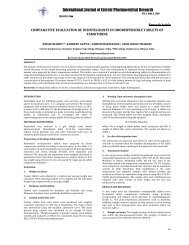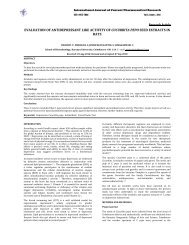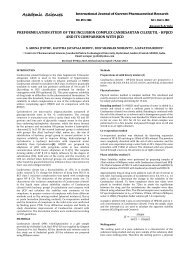ANTIMICROBIAL ACTIVITY OF AQUEOUS EXTRACT OF Terminalia ...
ANTIMICROBIAL ACTIVITY OF AQUEOUS EXTRACT OF Terminalia ...
ANTIMICROBIAL ACTIVITY OF AQUEOUS EXTRACT OF Terminalia ...
You also want an ePaper? Increase the reach of your titles
YUMPU automatically turns print PDFs into web optimized ePapers that Google loves.
otary evaporator and the crude extracts<br />
were dried at room temperature in a<br />
steady air current. The dried extracts were<br />
then stored in an air tight jars at 4 o C for<br />
anti‐microbial analysis.<br />
Formulation of extract<br />
For anti‐microbial activity study on the day<br />
of experimentation, the different amount of<br />
powder was suspended in distilled water<br />
to get different concentration of<br />
suspension.<br />
Microorganism<br />
The microorganisms used in this study<br />
were B.subtilus (NCIM2493), S.aureus<br />
(NCIM2079), S.epidermis (NCIM2493), E.coli<br />
(NCIM2065), S.flexineria (NCIM2418),<br />
P.auriginosa (NCIM2200).<br />
Antimicrobial activity<br />
The anti microbial activity of the aquous<br />
extract was carried by disc diffusion<br />
method. 11 A suspension of tested<br />
microorganisms was spread on Muller‐<br />
Histon Agar (MHA) (Oxoid) medium. The<br />
filter paper discs (5mm in diameter) were<br />
individually impregnated with different<br />
concentration of extract and then placed<br />
into the agar plates which had previously<br />
been inoculated with the tested<br />
microorganisms. The plates were<br />
subsequently incubated at 37 o C for 24 Hrs.<br />
After incubation the growth inhibition<br />
rings were quantified by measuring the<br />
diameter of the zone of inhibition in mm.<br />
All the tests were performed in triplicate.<br />
Tobramycin, cephalexin, erythromycin and<br />
ampicillin served as positive control.<br />
RESULT AND DISCUSSION<br />
Invitro preliminary screening of the<br />
antimicrobial activity of the plant extracts<br />
from T.chebula was studied against some<br />
micro‐organisms using the filter paper disc<br />
diffusion method. The antimicrobial affect<br />
of plant extract against the different strains<br />
are illustrated in Table 1 and Figures 1.<br />
The extract of T.chebula at the<br />
concentration of 100% has antimicrobial<br />
activity on the tested microorganism form<br />
high to low respectively. P.auriginosa<br />
(19mm), E.coli (16mm), S. epidermis<br />
(15mm), S. aureus(15mm), S. flexineria<br />
(14mm), and B.subtilus (14mm) showed in<br />
Table ‐1.<br />
Table1 shows that the extract of T. chebula<br />
have activity on B.subtilus, S.aureaus, S.<br />
epidermis, E. coli, S. flexineria , P. auriginosa<br />
(14mm, 15mm, 15mm, 16mm, 14mm,<br />
and19mm inhibition zone respectively).<br />
The data indicated that gram negative P.<br />
auriginosa was the most sensitive strain of<br />
those tested with the extract of T. chebula,<br />
with strongest inhibition zone of 19mm.<br />
The extract concentration of 100% also<br />
exhibit high antimicrobial activity against<br />
E.coli., with modest activity against<br />
S.epidermis, S. aureaus, B.sustilus, S.<br />
flexineria. The 75% concentration of the<br />
extract of T.chebula also show strongest<br />
inhibition zone against different strains of<br />
microorganisms. The data indicates that<br />
anti‐microbial activity of extract (at 75%<br />
concentration) with strongest inhibition<br />
zone of 14mm for the strain of<br />
P.auroginosa, E.coli, and S.epidermis.<br />
However, the inhibition zone for the<br />
species of B.subtilus, S. aureaus and<br />
S.flexinaria was found 13mm, 12mm and<br />
11mm respectively.<br />
The Table‐1 shows that different<br />
concentration (50%, 75% and 100%) of<br />
plant extract were having good antimicrobial<br />
activity against B.subtileaus,<br />
S.aureaus, S.epedermis, E.coli, S.flexineria<br />
and P.auriginosa.<br />
The minimum inhibitory concentration<br />
(MIC) of the T. chebula fruit extract was<br />
meausered which is depicted in the<br />
Table‐1. It was observed that S. aureaus<br />
and P. auriginosa have shown MIC value<br />
at 1% concentration of plant extract.<br />
57



